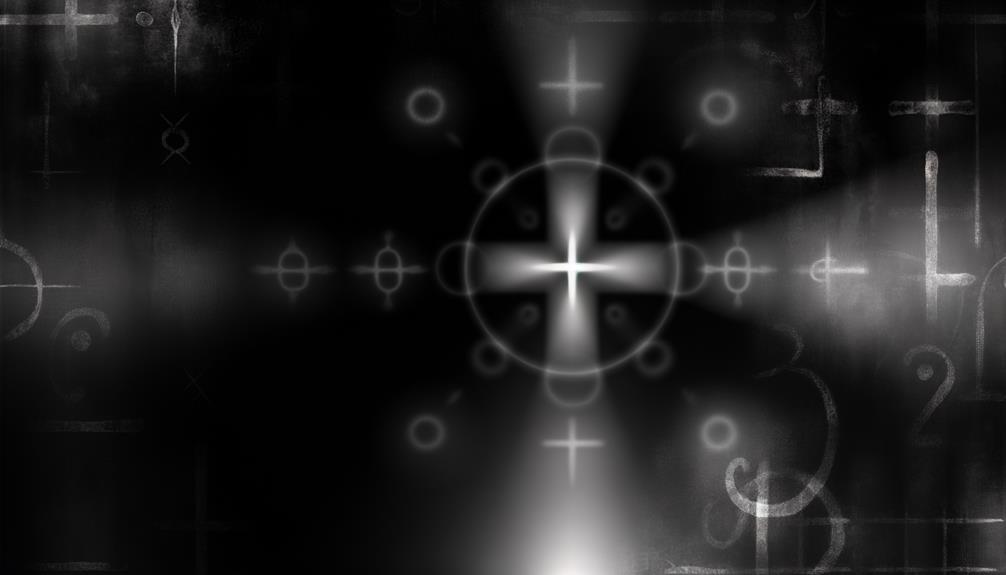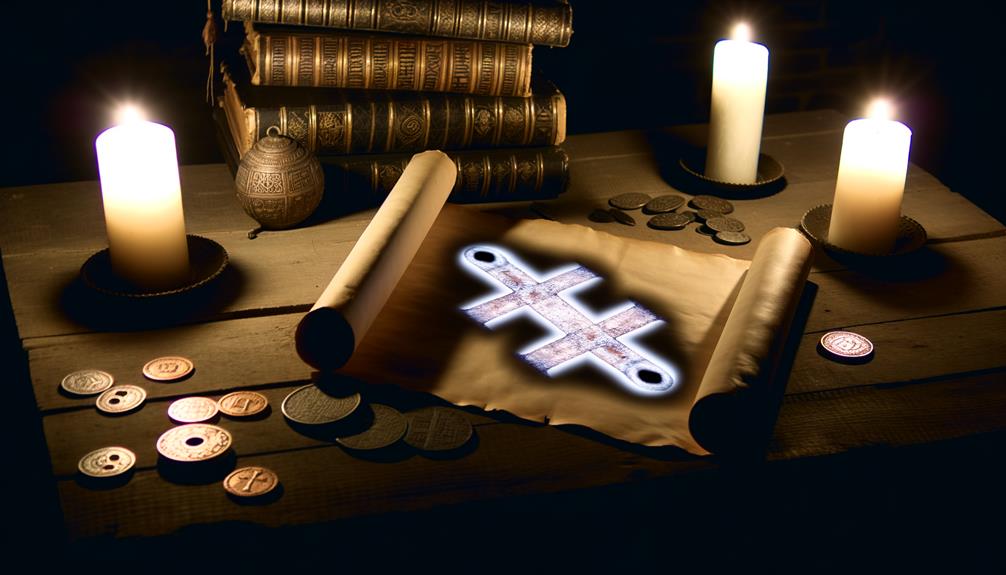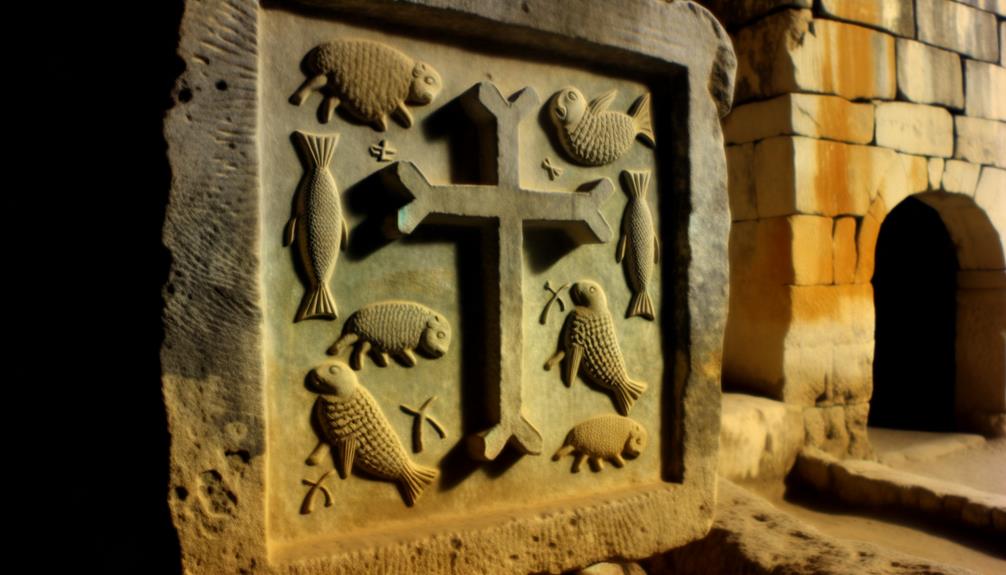What Is the Upside Down Cross Symbol’s Historical Meaning?
The upside-down cross, also known as the Cross of Saint Peter, is rooted in early Christian symbolism. Traditionally, it represents humility and unworthiness, as Saint Peter requested to be crucified upside down, feeling unworthy to die in the same manner as Jesus.
This symbol initially stood for profound faith and devotion within Christian communities. However, its portrayal in modern culture, particularly in horror films and heavy metal music, has led to associations with rebellion and anti-Christian sentiments.
The shift in interpretation highlights evolving societal and religious perspectives. For a deeper understanding, further exploration reveals the symbol's multifaceted nature.

Key Takeaways
- Historically, the upside-down cross symbolizes humility, associated with Saint Peter's martyrdom.
- Saint Peter requested an inverted crucifixion, feeling unworthy to die like Jesus.
- Modern misinterpretations link it to anti-Christian sentiment, often seen in horror and heavy metal contexts.
- Contemporary use includes rebellion and nonconformity against traditional religious norms.
- The symbol's evolving meanings reflect its dynamic role in cultural and individual expression.
Historical Origins

The historical origins of the upside down cross symbol can be traced back to early Christian traditions and the martyrdom of Saint Peter. This symbol, also known as the Cross of Saint Peter, emerged within the context of early Christianity as a representation of humility and unworthiness in comparison to Christ.
The inverted cross was initially utilized by early Christians to differentiate Saint Peter's crucifixion from that of Jesus, thereby emphasizing a theological distinction. Over time, the symbol has been appropriated and interpreted in various ways, often straying from its original context.
Understanding its historical roots is pivotal for an accurate interpretation, as contemporary uses can distort its foundational significance, transforming it into a symbol laden with misconceptions and modern reinterpretations.
Saint Peter's Martyrdom
Saint Peter's martyrdom holds significant relevance to the symbolism of the upside-down cross. According to historical accounts, Peter requested to be crucified upside down as he felt unworthy to die in the same manner as Jesus Christ.
This act of humility has since been pivotal in understanding the origin and meaning of the inverted cross within Christian iconography.
Peter's Humble Request
According to historical accounts, Peter requested to be crucified upside down, feeling unworthy to die in the same manner as Jesus Christ. This request is often interpreted as a profound act of humility, emphasizing Peter's deep reverence for Jesus.
It is recorded that Peter, one of Jesus' closest disciples and the reputed first Pope, chose this form of crucifixion to distinguish his martyrdom from that of Christ. This decision highlights the early Christian ethos of humility and submission to divine will.
Additionally, Peter's request underscores the theological distinction between the human and divine, acknowledging his own fallibility in contrast to Jesus' divinity. This narrative is pivotal in understanding the symbolism associated with the upside-down cross.
Inverted Cross Origins
Often, the origin of the inverted cross symbol is traced back to the martyrdom of Peter, which serves as a significant point of reference in early Christian history. According to tradition, Peter, one of Jesus Christ's apostles, was crucified upside down at his own request. This request stemmed from his belief that he was unworthy to die in the same manner as Christ.
The inverted cross, as a result, became emblematic of humility and profound respect in the Christian context. Over time, this symbol has been subject to varying interpretations, yet its historical roots lie in the narrative of Peter's humility and sacrifice.
Understanding this origin is vital to discerning the multifaceted meanings attributed to the inverted cross in both historical and modern contexts.
Early Christian Symbolism

In the context of early Christian symbolism, the upside-down cross is intrinsically linked to the martyrdom of Saint Peter, who, according to tradition, requested to be crucified in this manner as an expression of humility and unworthiness compared to Jesus.
This act of inversion became a powerful symbol within early Christian communities, reflecting broader themes of humility and sacrifice that were central to their faith.
Peter's Crucifixion Symbolism
Peter's crucifixion, which according to tradition involved being nailed to an inverted cross at his own request, symbolizes humility and the distinctiveness of his martyrdom within early Christian symbolism. This act differentiated Peter from Christ, as he deemed himself unworthy to die in the same manner. The inverted cross, thus, became a poignant emblem of his reverence and unique sacrifice.
Early Christians viewed this symbol as a testimony to Peter's profound faith and devotion. By choosing this method of crucifixion, Peter's martyrdom underscored the principles of self-effacement and fidelity to Christian teachings. This narrative, while rooted in ecclesiastical tradition, highlights the broader context of early Christian values and their manifestation through individual acts of piety.
Humility in Early Christianity
Within the framework of early Christian symbolism, humility was exemplified through various acts and symbols that underscored the believers' commitment to self-effacement and spiritual devotion. This humility was not only a personal virtue but also a public attestation of their faith. Early Christians employed various symbols to convey this humility, including the fish (Ichthys), the anchor, and the upside-down cross—believed to honor Apostle Peter's request for an inverted crucifixion, feeling unworthy to die as Jesus did.
| Symbol | Meaning | Context |
|---|---|---|
| Ichthys | Jesus Christ, Son of God, Savior | Secret identification amid persecution |
| Anchor | Hope and steadfastness | Often found in catacombs, symbolizing hope in Christ |
| Upside-down Cross | Humility and martyrdom | Linked to Peter's crucifixion, signifying unworthiness |
| Chi-Rho | Christ's monogram | Early Christian symbol combining Greek letters Χ and Ρ |
| Dove | Holy Spirit and peace | Frequently depicted in art and baptismal contexts |
Cultural Misunderstandings
Numerous cultural misunderstandings have contributed to the controversial perception of the upside-down cross symbol.
Historically, this symbol was associated with St. Peter, who, according to Christian tradition, requested to be crucified upside down out of humility.
However, over time, the symbol has been co-opted by various subcultures and media, often being misrepresented as an anti-Christian emblem.
This misinterpretation has been perpetuated by its frequent use in horror films and heavy metal music, where it is depicted as a sign of rebellion or satanic affiliation.
Such portrayals have overshadowed its original connotation, leading to widespread confusion.
Consequently, the upside-down cross has become a contentious symbol, embodying a complex interplay of historical reverence and modern misappropriation.
Modern Interpretations

In contemporary society, the upside-down cross symbol has evolved to encompass a variety of interpretations beyond its original religious significance. Modern interpretations include its use as a symbol of nonconformity, rebellion, and critique of established norms.
Some groups adopt it to question traditional religious structures or to signify personal spiritual journeys that diverge from orthodox paths. Additionally, in certain contexts, it has been reinterpreted as an emblem of humility, aligning with the historical narrative of Saint Peter's crucifixion.
The symbol's versatility in meaning reflects broader societal shifts towards pluralism and individualism, where symbols are often redefined to resonate with contemporary values and experiences. This multifaceted understanding underscores the dynamic nature of symbolism in modern discourse.
Pop Culture Influence
The upside-down cross has permeated various facets of pop culture, often serving as a provocative visual element in music, film, and fashion. Its usage is frequently intended to evoke strong emotional responses and challenge societal norms. In popular media, this symbol is utilized in diverse contexts:
- Music: Artists employ it to signify rebellion or anti-establishment sentiments.
- Film: It appears in horror genres to evoke fear and unsettlement.
- Fashion: Designers integrate it as a statement piece within alternative and goth subcultures.
- Art: It is used to critique religious and cultural conventions.
These applications illustrate how the upside-down cross transcends its traditional meanings, becoming a multifaceted emblem that incites dialogue and reflection within contemporary culture.
Religious Reactions

While the upside-down cross has found a place in pop culture, its representation within religious contexts often sparks intense debate and controversy.
Traditionally, the inverted cross is associated with St. Peter, who, according to Christian tradition, requested to be crucified upside down out of humility, deeming himself unworthy to die in the same manner as Jesus.
However, this symbol has been appropriated and recontextualized, frequently viewed as an anti-Christian emblem by various groups and individuals.
This duality creates tension within religious communities, as the symbol's original meaning of humility and martyrdom contrasts sharply with its modern associations.
Consequently, the upside-down cross remains a powerful and polarizing figure in religious discourse, reflecting deeper cultural and interpretative divides.
Symbol in Art and Media
How has the upside-down cross evolved into a potent symbol within contemporary art and media, diverging notably from its religious origins?
In modern contexts, this symbol has been repurposed to convey a variety of meanings, often detached from its traditional Christian connotations.
Artists and media creators utilize the upside-down cross to invoke themes such as rebellion, subversion, and counterculture.
- Rebellion: Used to challenge established norms and authority.
- Subversion: Symbolizes a break from conventional religious symbolism.
- Counterculture: Embraced by subcultures to signify nonconformity.
- Commercialization: Adopted in fashion and entertainment for its shock value.
This recontextualization underscores the fluidity of symbols and their ability to acquire new meanings in different cultural landscapes.
Conclusion
The upside-down cross, steeped in historical and religious significance, has traversed a complex journey from Saint Peter's martyrdom to modern misinterpretations.
Often misconstrued as a symbol of anti-Christian sentiment, its origins and early Christian symbolism reveal a narrative of humility and faith.
Contemporary interpretations, fueled by pop culture and media, underscore the profound cultural misunderstandings that envelop this emblem.
As a double-edged sword, it continues to evoke diverse reactions, reflecting society's evolving perspectives on religious symbolism.





